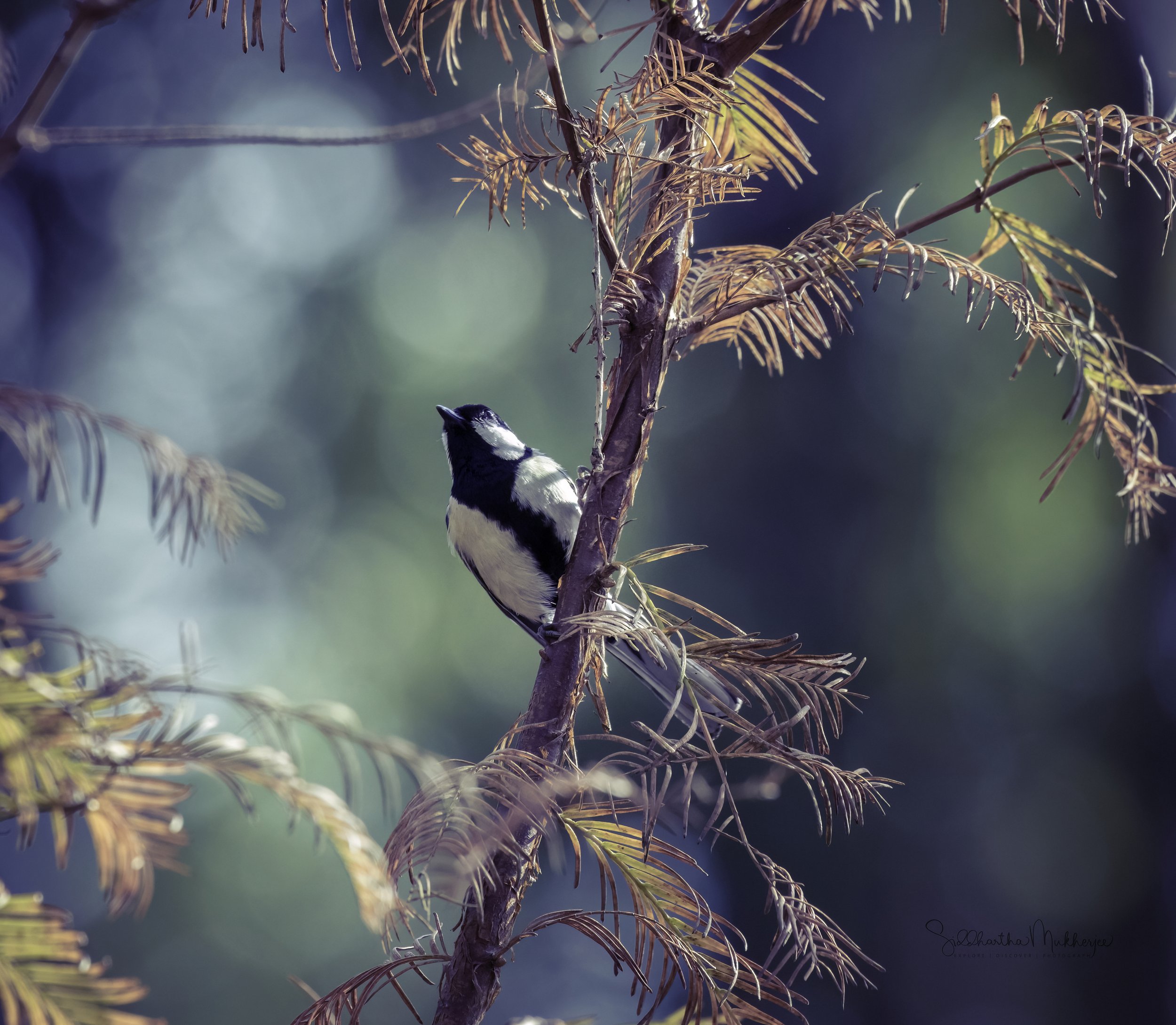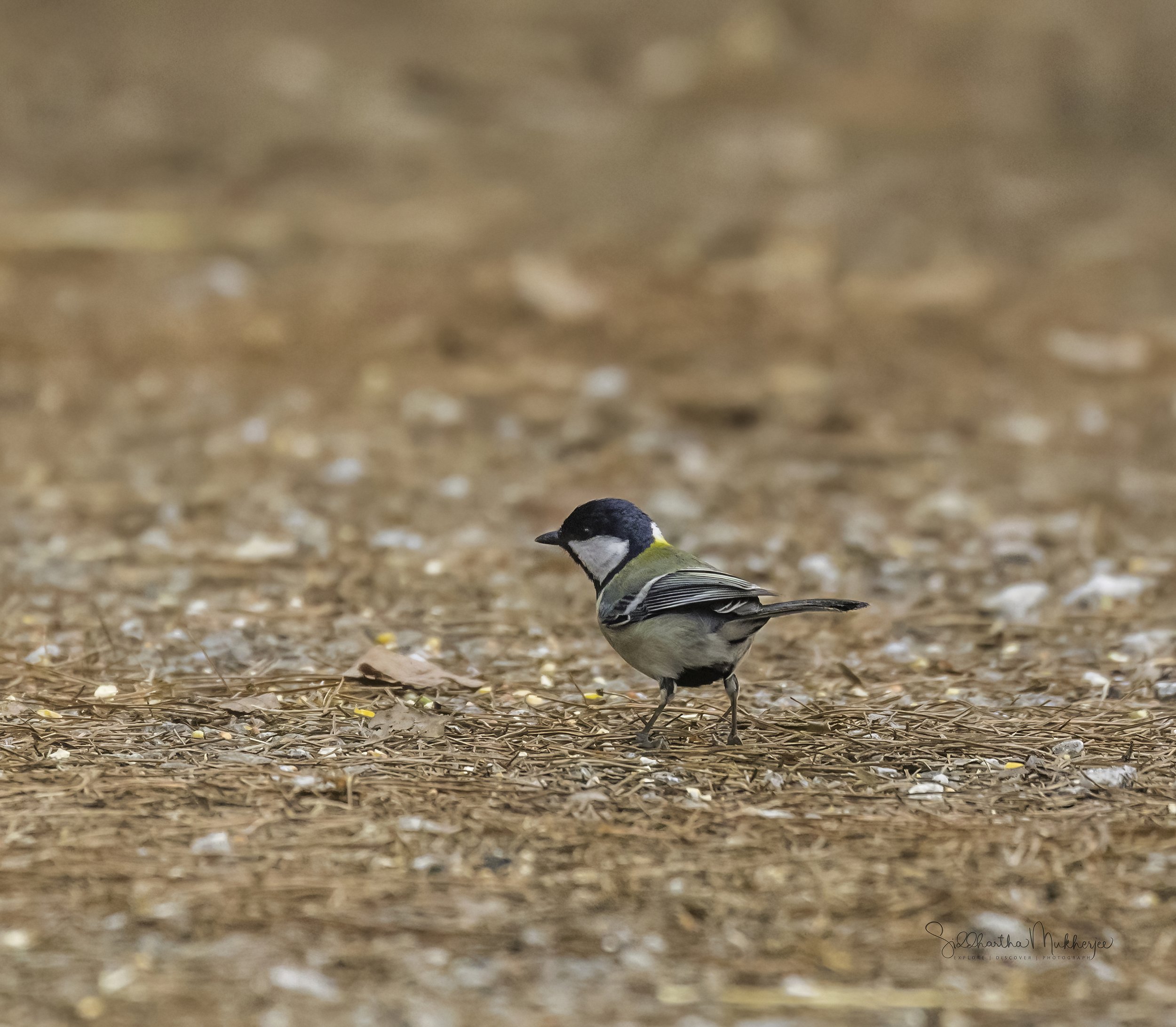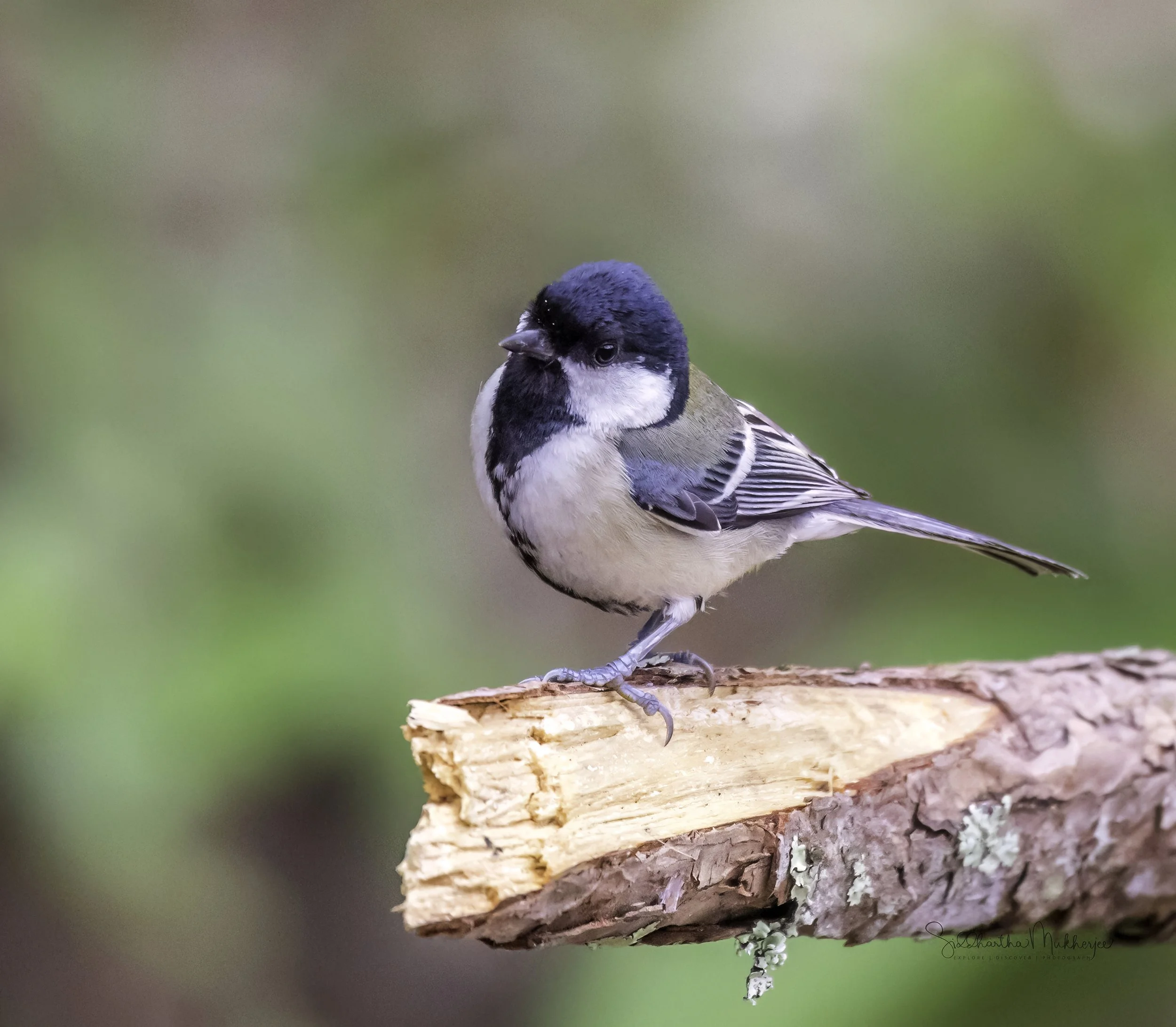Japanese Tit/ Oriental Tit
Parus minor
Doi Luang, Chiang Mai, Thailand
After the exotics of the past few weeks, I thought I would get back to some of the common and often ignored passerines. A passerine is any bird of the order Passeriformes (/ˈpæsərɪfɔːrmiːz/; from Latin passer 'sparrow' and formis '-shaped'), which includes more than half of all bird species. Sometimes known as perching birds, passerines generally have an anisodactyl arrangement of their toes (three pointing forward and one back), which facilitates perching.
With more than 140 families and some 6,500 identified species, Passeriformes is the largest order of birds and among the most diverse clades of terrestrial vertebrates, representing 60% of birds. Passerines are divided into three clades: Acanthisitti (New Zealand wrens), Tyranni (mostly-South American suboscines), & Passeri (oscines or songbirds). The passerines contain several groups of brood parasites such as the viduas, cuckoo-finches, and the cowbirds. Most passerines are omnivorous, though shrikes are carnivorous, and others are insectivorous.
The terms "passerine" and "Passeriformes" are derived from the scientific name of the house sparrow, Passer domesticus, and ultimately from the Latin term passer, which refers to sparrows and similar small birds.
The passerine in focus today is the Japanese Tit or Oriental Tit.
The Dois of northern Thailand have been very kind to me from a birding perspective. There are so many I have already talked about and so many still remaining. I have written an overview here on the Birds of the Dois and have now started to break them up into individuals like the Gray-backed Shrike, Long-tailed Shrike, Spectacled Barwing, Siberian Rubythroat, the stunning Mrs. Gould’s Sunbird and the numerous other birds I have seen here.
About 685 kilometers to the north of Bangkok lies the former seat of the ancient Lanna Kingdom and is considered one of the most scenic provinces in the country given its mountain ranges, valleys, flora and fauna. A land of misty mountains and colourful hill tribes, a playground for seasoned travellers, and a delight for adventurers. Despite its relatively small size and blissful calm, Chiang Mai truly has it all, a city that is still firmly Thai in its atmosphere and attitude. It is the second-largest changwat (province) of Thailand. Bordered by Chiang Rai to the northeast, Lampang and Lamphun to the south, Tak to the southwest, Mae Hong Son to the west and the Shan State of Myanmar to the north. Located in a verdant valley on the banks of the Ping River, Chiang Mai was founded in 1296 as the capital of the ancient Lanna Kingdom. Today it is a place where past and the present seamlessly merge with modern buildings standing side by side with venerable temples. Of all the places I have visited in Thailand, Chiang Mai with its forests and mountains and the historic city of Ayutthaya are by far my favourites.
The word Chiang itself is from North Thai, or Lanna, meaning town or city and Mai means new making Chiang Mai the New City as it was founded later than Chiang Rai, the earlier capital of King Meng Rai. The districts in the province are called amphoe, and sub-districts are called tambon. Another twist is the use of Nakhon (or Nakorn or Nakhorn), derived from the Sanskrit word Nagara, also means city, though strictly speaking it refers to a capital city such as Nakorn Sri Ayutthaya (more on Ayutthaya later). Indeed to emphasise its former status you may sometimes see Chiang Mai referred to as Nakhon Ping. Other common names of geographical features include mae (river) and doi which is north Thai for mountain - for example Doi Inthanon and Mae Ping.
The four Dois we spent our time on were Doi Inthanon, Doi Ang Khang, Doi Luang and Doi SanJu.
Doi Luang & Doi SanJu in close proximity to the Doi Pha Hom Pok National Park, it is the second highest mountain in Thailand and a part of the Dan Lao Mountain range, northwest of Chiang Mai, sharing the border with Myanmar. Doi SanJu, can be easily accessed from Fang town. The mountain forest and no traffic make it easy to view birds. The entire area is very quiet, secluded and home to rare species like Mrs. Humes Pheasant, Long–tailed Sibia, Himalayan Cutia, Black–throated Tit, Black–eared Shrike Babbler, Whiskered Yuhina, Crimson–breasted Woodpecker, Fire–tailed Sunbird to name a few.
We didn’t have the good fortune to see all the species on all the mountains, that would have been impossible, but we did rack up quite a number of species - about 95 of them. Read about the other birds from these beautiful mountains. These are only a few of the huge number I have spotted and recorded there.
With that said, lets meet this lovely tit from the mountains of Chiang Mai.
‡‡‡‡‡
Japanese Tit/ Oriental Tit
The Japanese Tit (Parus minor), also known as the Oriental Tit, is a distinctive passerine bird which replaces the similar great tit in Japan and the Russian Far East beyond the Amur River, including the Kuril Islands. Until recently, this species was classified as a subspecies of great tit (Parus major), but studies indicated that the two species coexist in the Russian Far East without intermingling or frequent hybridization.
The Japanese Tit is about 12·5–15 cm and weighs between 11·9–22·1 grams. It is a large, black-headed tit with large white face patch , and pale or yellow underparts divided by black ventral line. The male of the nominate race is a glossy bluish black from the forehead to crown (to below eye) and nape, and a dull whitish patch on the centre of the lower nape becoming greenish yellow on lowermost hindneck and upper mantle. The cheek and ear-coverts are white, chin, throat and neck side to centre of upper breast is black (slight blue gloss on throat and breast), and a fairly broad but irregular black line runs from the lower bib to the vent. The sides of the breast and belly are a bright lemon-yellow, while the flanks are a washed grey-green.
The iris is a dark reddish brown to blackish brown, with a black bill, paler cutting edges and the legs are slate-grey to blue-grey. The female is like the male, but slightly duller black on crown, and the upperparts a duller or darker green, the fringes of the greater coverts and secondaries greenish grey (not greyish blue), black on side of neck narrower or broken, the bib a duller black, ventral line narrower and less intensely black (may be broken or show white tips towards vent), undertail-coverts more extensively white.
The race bokharensis was previously treated as a separate species, but are now included herein, based on vocal, morphological and genetic similarities. The geographical variation is complex and partly clinal, but 3–4 groups of races commonly recognized: “major”, in Palearctic (except far east), containing green-backed, yellow-bellied races (14 races); “bokharensis”, of C Asia, with small, pale and grey forms (5 races); “cinereus”, from SW Asia and Indian Subcontinent E to Indochina and Indonesia, containing grey-backed, whitish-bellied forms (12 races; intermedius may also prove to belong here); and “minor”, from E Asia and Japan, incorporating greenish-backed, white-bellied races (12 races). Molecular analysis suggests these groups, which also reflect some differences in voice and habitat, could be treated as species; but
there are contact zones affecting all groups,
taxa differ on relatively minor morphological and mensural characters,
vocal distinctions are not strong,
genetic and vocal samplings derive from a relatively small number of sites and
more recent molecular work suggests rather low levels of divergence.
Further integrative analysis needed to support or reject multiple splits. Race kagoshimae merged with minor by some authors. Race nigriloris appears unusually distinct and may merit further research. Race planorum previously listed as nipalensis, but that name preoccupied and replaced under First Reviser action. Forty-three subspecies are recognised.
SUBSPECIES of the Japanese Tit (Parus minor group)
Parus minor minor - Darker-flanked birds described as P. m. kagoshimae (Brazil 1991) are considered variant. Proposed subspecies P. m. wladiwostokensis, and P. m. artatus are also subsumed within this race. Occuring from eastern Tibet, south-western China, through south-eastern Russia, Korea to Japan.
Parus minor dageletensis - Endemic to Ullŭng Island, South Korea. Like P. m. minor but ventral stripe narrower, with less greenish upperparts and whiter underparts.
Parus minor tibetanus - Distributed from south-western China to south-eastern Tibet. Also recorded in Sikkim. Similar to the slightly smaller nominate but has less green on mantle and more white in outer two outer tail-feathers.
Parus minor subtibetanus - Occurs from south-eastern Tibet, through southern China and north-western Myanmar. Very similar to P. m. tibetanus which it is often synonymized.
Parus minor nubicolus - Occurs from south-eastern Myanmar across northern Thailand, through Laos and extreme western Tonkin. Resembles P. m. tibetanus but slightly yellower on mantle.
Parus minor commixtus - Occurs in China south of the Yangtze River to Hong Kong, through eastern Tonkin, coastal central Annam. Upperparts grayer and less olive-green than the previous subspecies group, recalling Cinereous Tit (P. cinereus). Underparts also slightly darker and in fresh plumage tinged pinkish. The amount of white in outer two rectrices varies.
Parus minor amamiensis - Endemic to Amami Ōshima and Tokuno-Shima in the Amami Archipelago, Northern Ryukyu Islands. Differs from nominate in having olive-green restricted to the upper mantle, contrasting sharply with gray lower mantle and rump.
Parus minor okinawae - Endemic to Okinawa and Yagaji in the Central Ryukyu Islands. Similar to P. m. amamiensis but upperparts darker gray and upper mantle less green.
Parus minor nigriloris - Endemic to Ishigaki and Iriomote of South Ryukyu Islands. Darker than the closest subspecies P. m. okinawae. Nuchal patch is lacking. Upperparts dark bluish gray, with slightly glossy mantle. White in tail restricted to tip of outermost feather. White on cheeks much less extensive than other subspecies, surrounded by black neck-sides merging with cap, lores, bib and ventral stripe. Flanks darker gray. Often treated as part of Cinereous Tit or recognized as a full species on the basis of highly distinctive plumage and vocalizations.
The Japanese Tit or Oriental Tit mostly prefers open deciduous and mixed forests and edges and clearings in dense forest, including conifer forests and the boreal taiga of N Siberia; also seen more widely in plantations, hedgerows, orchards, parks, gardens (including in urban and suburban areas), edges of cultivation, olive groves and almost any group of trees or bushes. In Europe they show preference for oaks (Quercus); in Siberia, W China and Mongolia principally in riverine birch (Betula) or willow (Salix) thickets and mixed forest, and in isolated clumps of trees on otherwise open steppe, around villages and other settlements, in Mongolia also in open semi-desert and montane forest. In the Himalayas they are seen mostly in deciduous and mixed forest, preferably open forest of oak, but also horse chestnut (Aesculus), pine and deodar (Cedrus deodar) and, E of N Pakistan, sal (Shorea) forest and acacia (Acacia) groves, and at higher levels in orchards, poplars (Populus) and willows. In peninsular India, W Myanmar and N Thailand they are found mainly in dry deciduous forest, groves or scattered trees in open and hilly country, but rarely in evergreen forest (except in NW Thailand, where they evidently prefer stands of pines in evergreen forest).
‡‡‡‡‡
Related Posts




















